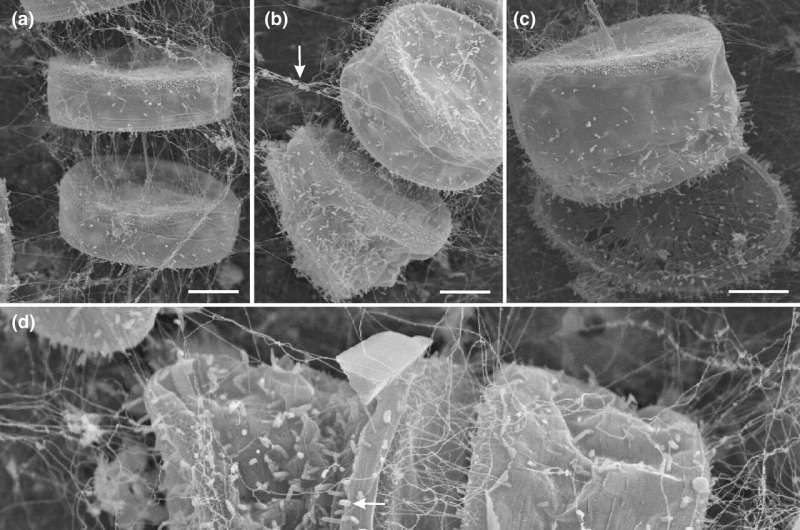This article has been reviewed according to Science X's editorial process and policies. Editors have highlighted the following attributes while ensuring the content's credibility:
fact-checked
peer-reviewed publication
proofread
Study shows diatoms provide an attractive habitat for bacteria

Single-celled algae and marine bacteria live in a complex but largely unexplored relationship. Now, a new study shows that the surface of diatoms is a surprisingly diverse habitat for bacteria. A team from the University of Oldenburg was able to demonstrate for the first time that the surface displays distinct microscale biochemical variations. The colonization by different bacterial species is finely tuned to this structure. Since diatoms bind large amounts of carbon and form the basis of marine food webs, their relationship with bacteria is of fundamental importance for the climate and ecology of the oceans.
Unicellular algae are an attractive and surprisingly diverse habitat for marine bacteria. A research team led by microbiologist Professor Dr. Meinhard Simon from the University of Oldenburg has now shown for the first time how different species of bacteria tend to colonize different parts of a common microscopic diatom from the North Sea. The team presents the results of its study in the current issue of the Journal of Phycology, shedding light on the complex interactions between algae and bacteria which are of fundamental importance for material cycles and food webs in marine environments.
Diatoms are an important type of phytoplankton—the mostly microscopic, single-celled algae that live in the world's oceans. Enclosed in a solid silicate shell, diatoms produce about a fifth of the oxygen in the Earth's atmosphere and also convert carbon dioxide from the air into biomass during photosynthesis, binding more CO2 than the tropical rainforests, which is why they play a key role in the carbon cycle and for the climate.
"Diatoms live in close association with bacteria, yet little is known about many aspects of their interactions," Simon explained. The biologist and his team have now taken a closer look at these microscopic interactions which are of vital importance for the ecology and biochemistry of the oceans.
The Oldenburg team led by Professor Simon, Dr. Sara Billerbeck and doctoral candidate Tran Quoc Den selected a commonly occurring diatom called Thalassiosira rotula and used various microscopy methods to conduct a detailed analysis of its colonization by bacteria. Dr. Thomas Neu from the Helmholtz Centre for Environmental Research in Magdeburg was also involved in the study.
Using fluorescent dyes, the researchers were able to demonstrate that the surface of this alga displays distinct microscale biochemical variations. They used lectins—complex biochemical compounds that bind very specifically to certain protein-carbohydrate complexes—to mark the different areas on the surface of the alga, stain them, and with the help of a special microscope make them visible as 3D images.
The scientists also found out that different species of bacteria specialize in colonizing different areas of the algae. The observed bacteria belonged mainly to the Roseobacter group and the Flavobacteria strain.
"The cell surface of diatoms is surprisingly diverse in its structure. We hadn't expected the colonization by the different bacterial species to be so finely tuned to this structure," Simon explained. The team also observed that certain bacterial species are more commonly found on fine hairs or "threads" on the surface of the algae.
"The colonization patterns reflect the highly diverse metabolic properties of different bacterial species and their abilities to colonize surfaces," said Simon, summarizing the team's findings.
These results are also interesting because they provide an insight into the diatoms' microenvironment. Known as the "phycosphere", this environment is rich in organic substances excreted by the algal cells.
"Previous studies have shown that the algae use this to attract certain bacteria that produce substances which are vital for their survival, for example vitamins—similar to the way plants attract bees with their flowers," Simon explained. "Building on these new findings, future studies could examine in greater detail the precise function of the different bacterial species in the phycosphere."
More information: Tran Quoc Den et al, Distinct glycoconjugate cell surface structures make the pelagic diatom Thalassiosira rotula an attractive habitat for bacteria, Journal of Phycology (2022). DOI: 10.1111/jpy.13308
Journal information: Journal of Phycology
Provided by Carl von Ossietzky-Universität Oldenburg




















